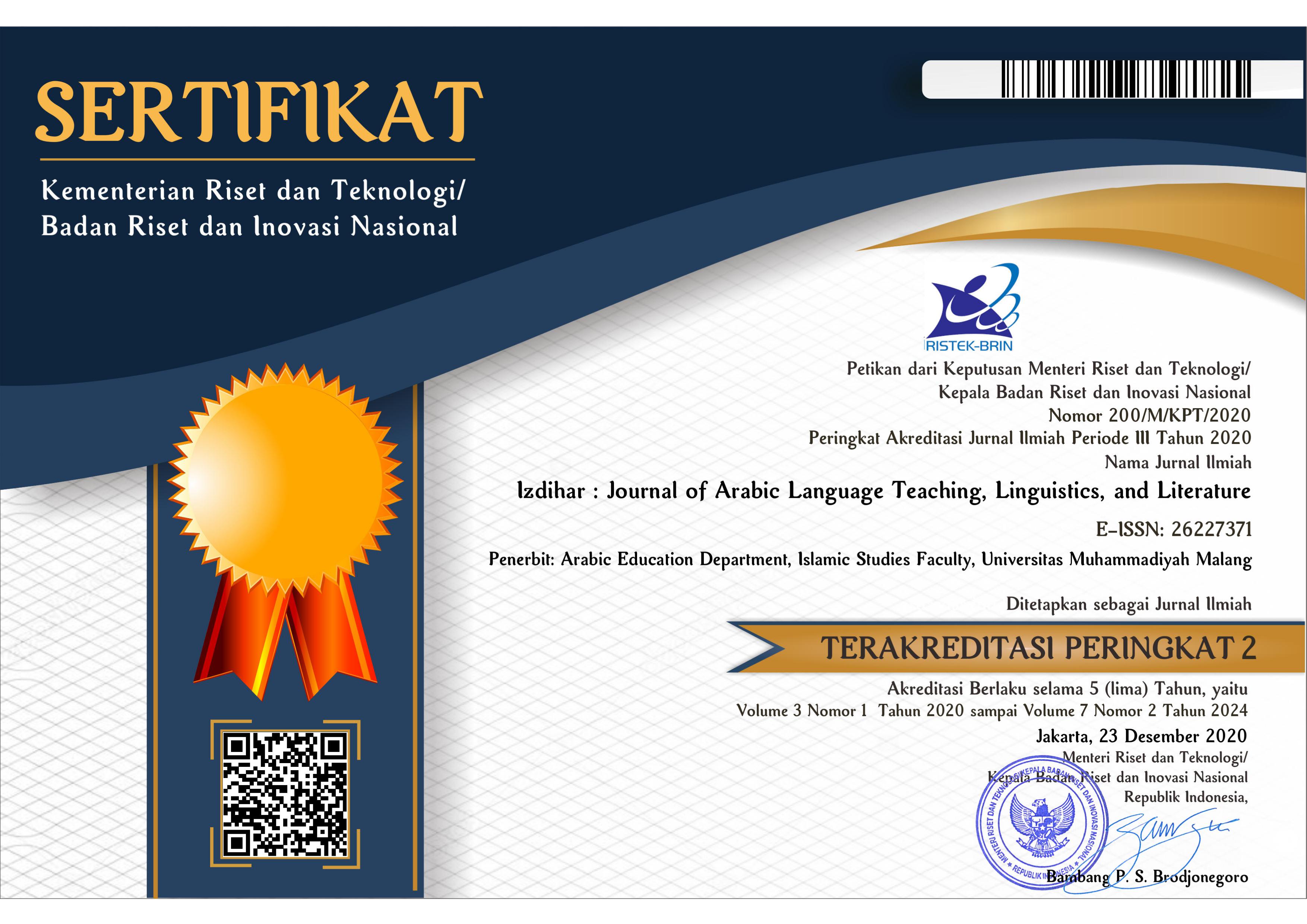Web Based Assessment Alternative for Arabic Online Exam
DOI:
https://doi.org/10.22219/jiz.v4i2.16525Keywords:
web based assessment, evaluasi bahasa arab, gnomio.comAbstract
This study to explore the steps of web-based assessment using gnomio.com as a mean of evaluation during online Arabic language Course. This work uses a descriptive qualitative approach. As many as 56 college students of IAIN Palangka Raya were the subject of this work. The data collected for this work was obtained through direct observation, open response questionnaires, and interviews. The result of this work shows that the utilization of web-based assessment using gnomio.com on those students is well accepted in terms of perceived ease of use and perceived usefulness. The mobility indicator on perceived ease of use bolsters along with the pandemic situation. In terms of the Perceived usefulness of Web based assessment using gnomio.com, it gives feedback to the students compared to other applications.
Downloads
References
Abass, O. A., Olajide, S. A., & Samuel, B. O. (2017). Development of web-based examination system using open source programming model. Turkish Online Journal of Distance Education, 18(2), 30-42. https://doi.org/10.17718/TOJDE.306555
Amalia, T. (2019). Penggunaan media google form dalam evaluasi pembelajaran bahasa Arab maharah kitabah. Prosiding Konferensi Nasional Bahasa Arab, 5(5), 318–323. http://prosiding.arab-um.com/index.php/konasbara/article/view/501
Arpaci, I. (2016). Understanding and predicting students’ intention to use mobile cloud storage services. Computers in Human Behavior, 58, 150–157. https://doi.org/10.1016/j.chb.2015.12.067
Arthur, W., Doverspike, D., Muñoz, G. J., Taylor, J. E., & Carr, A. E. (2014). The use of mobile devices in high-stakes remotely delivered assessments and testing. International Journal of Selection and Assessment, 22(2), 113–123. https://doi.org/10.1111/ijsa.12062
As’ari, D. R. (2017). Pemanfaatan wordershare quiz creator dalam pembuatan soal-soal bahasa Arab. Arabi : Journal of Arabic Studies, 2(1), 37–46. https://doi.org/10.24865/ajas.v2i1.24
Avraamidou, L. (2006). Exploring the influence of web-based portfolio development on learning to teach elementary science. Association for the Advancement of Computing in Education Journal, 14(2), 178–205. https://eric.ed.gov/?id=EJ809008
Batubara, H. (2013). , Pembelajaran berbasis web moodle dengan versi 3.4. Deepublish.
Bouzidi, L., & Jaillet, A. (2009). Can online peer assessment be trusted? Educational Technology & Society, 12(4), 257–268. https://www.jstor.org/stable/jeductechsoci.12.4.257
Chang, C.-C., Tseng, K.-H., Chou, P.-N., & Chen, Y.-H. (2011). Reliability and validity of web-based portfolio peer assessment: a case study for a senior high school’s students taking computer course. Computers & Education, 57(1), 1306–1316. https://doi.org/10.1016/j.compedu.2011.01.014
Cheon, J., & Grant, M. M. (2012). The effects of metaphorical interface on germane cognitive load in web-based instruction. Educational Technology Research and Development, 60(3), 399–420. https://www.jstor.org/stable/41488591
Ching, Y.-H., & Hsu, Y.-C. (2016). Learners’ interpersonal beliefs and generated feedback in an online role-playing peer- feedback activity: an exploratory study. The International Review of Research in Open and Distributed Learning, 17(2), 105-122. https://doi.org/10.19173/irrodl.v17i2.2221
Croft, A. C., Danson, M., Dawson, B. R., & Ward, J. P. (2001). Experiences of using computer assisted assessment in engineering mathematics. Computers & Education, 37(1), 53–66. https://doi.org/10.1016/S0360-1315(01)00034-3
Dahalan, H. M., & Hussain, R. M. R. (2010). Development of web-based assessment in teaching and learning management system (e-ATLMS). Procedia-Social and Behavioral Sciences, 9, 244–248. https://doi.org/10.1016/j.sbspro.2010.12.144
Davis, F. D. (1989). Perceived usefulness, perceived ease of use, and user acceptance of information technology. MIS Quarterly, 13(3), 319–340. https://doi.org/10.2307/249008
Fauzi, M. F., Murdiono, M., Anindiati, I., Nada, A. L. I., Khakim, R. R., Mauludiyah, L., & Thoifah, I. (2020). Developing Arabic language instructional content in canvas lms for the era and post covid-19 pandemic. Izdihar : Journal of Arabic Language Teaching, Linguistics, and Literature, 3(3), 161–180. https://doi.org/10.22219/jiz.v3i3.15017
Gebril, A., & Taha‐Thomure, H. (2013). Assessing Arabic. In The Companion to Language Assessment (pp. 1779–1789). American Cancer Society. https://doi.org/10.1002/9781118411360.wbcla065
Ilmiani, A. M., Ahmadi, A., Rahman, N. F., & Rahmah, Y. (2020). Multimedia interaktif untuk mengatasi problematika pembelajaran bahasa Arab. Al-Ta’rib Jurnal Ilmiah Program Studi Pendidikan Bahasa Arab, 8(1), 17–32. https://doi.org/10.23971/altarib.v8i1.1902
Iswanto, R. (2017). Pembelajaran bahasa Arab dengan pemanfaatan teknologi. Arabiyatuna : Jurnal Bahasa Arab, 1(2), 139–152. https://doi.org/10.29240/jba.v1i2.286
Joo, Y., Lee, H. W., & Ham, Y. (2014). Integrating user interface and personal innovativeness into the TAM for mobile learning in Cyber University. Journal of Computing in Higher Education, 26, 143–158. https://doi.org/10.1007/s12528-014-9081-2
Kluger, A., & DeNisi, A. (1996). The Effects of feedback interventions on performance: A historical review, a meta-analysis, and a preliminary feedback intervention theory. Psychological Bulletin, 119(2), 254–284. https://doi.org/10.1037/0033-2909.119.2.254
Lee, D., Moon, J., Kim, Y. J., & Yi, M. Y. (2015). Antecedents and consequences of mobile phone usability: Linking simplicity and interactivity to satisfaction, trust, and brand loyalty. Information & Management, 52(3), 295–304. https://doi.org/10.1016/j.im.2014.12.001
Nguyen, D. M., Hsieh, Y.-C., & Allen, G. D. (2006). The impact of web-based assessment and practice on students’ mathematics learning attitudes. Journal of Computers in Mathematics and Science Teaching, 25(3), 251–279. https://www.learntechlib.org/primary/p/6277/
Nikou, S. A., & Economides, A. A. (2016). The impact of paper-based, computer-based and mobile-based self-assessment on students’ science motivation and achievement. Computers in Human Behavior, 55(part B), 1241–1248. https://doi.org/10.1016/j.chb.2015.09.025
Nikou, S. A., & Economides, A. A. (2017). Mobile-based assessment: Investigating the factors that influence behavioral intention to use. Computers & Education, 109, 56–73. https://doi.org/10.1016/j.compedu.2017.02.005
Nikou, S. A., & Economides, A. A. (2018). Mobile-based assessment: A literature review of publications in major referred journals from 2009 to 2018. Computers & Education, 125, 101–119. https://doi.org/10.1016/j.compedu.2018.06.006
Olufisoye, A. C. (2012). An Essay-Based Examination Assessment Model Using Double Blind Marking Technique. https://api.semanticscholar.org/CorpusID:16834353
Park, E., & Joon Kim, K. (2013). User acceptance of long‐term evolution (LTE) services: An application of extended technology acceptance model. Program, 47(2), 188–205. https://doi.org/10.1108/00330331311313762
Rahman, N. F., Maimuna, M., & Ilmiani, A. M. (2020). Perkuliahan bahasa Arab dengan Gnomio.com. Proceeding NATHLA : al-Nadwah al-’Alamiyyah fi Ta’lim al-Lughah al-’Arabiyyah, 1(1), 167–178. https://doi.org/10.23971/nathla.v1i1.176
Ramadhani, D. A. (2018). Evaluasi bahasa Arab dalam ranah kemampuan kognitif peserta didik. Al Qalam: Jurnal Ilmiah Keagamaan Dan Kemasyarakatan, 12(1), 113–127. https://doi.org/10.35931/aq.v0i0.22
Ramadhani, D. A. (2019). Evaluasi pengajaran bahasa arab dengan media online di perguruan tinggi. Al Mi’yar: Jurnal Ilmiah Pembelajaran Bahasa Arab Dan Kebahasaaraban, 2(1), 85-104. https://doi.org/10.35931/am.v2i1.105
Rashad, M., Kandil, M., Hassan, A., & Zaher, M. (2010). An Arabic web-based exam management system. https://api.semanticscholar.org/CorpusID:14128930
Ritonga, A. W., Wargadinata, W., Hasan, N., & Ahmad, B. M. B. (2021). Teacher’s challenges in implementing hots in learning arabic during covid-19 pandemic. Izdihar : Journal of Arabic Language Teaching, Linguistics, and Literature, 4(1), 1–14. https://doi.org/10.22219/jiz.v4i1.15606
Romero, C., Ventura, S., & Bra, P. M. E. D. (2009). Using mobile and web-based computerized tests to evaluate university students. Computer Applications in Engineering Education, 17(4), 435–447. https://doi.org/10.1002/cae.20242
Salloum, S. A., Alhamad, A. Q. M., Al-Emran, M., Monem, A. A., & Shaalan, K. (2019). Exploring students’ acceptance of e-learning through the development of a comprehensive technology acceptance model. IEEE Access, 7, 128445–128462. https://doi.org/10.1109/ACCESS.2019.2939467
Scherer, R., & Siddiq, F. (2015). The big-fish–little-pond-effect revisited: Do different types of assessments matter? Computers & Education, 80, 198–210. https://doi.org/10.1016/j.compedu.2014.09.003
Setemen, K. (2010). Pengembangan evaluasi pembelajaran online. Jurnal Pendidikan Dan Pengajaran, 43(3), Article 3. https://doi.org/10.23887/jppundiksha.v43i3.124
Terzis, V., & Economides, A. A. (2011). The acceptance and use of computer based assessment. Computers & Education, 56(4), 1032–1044. https://doi.org/10.1016/j.compedu.2010.11.017
Wang, T.-H. (2018). Developing a web-based assessment system for evaluating examinee’s understanding of the procedure of scientific experiments. Eurasia Journal of Mathematics, Science and Technology Education, 14(5), 1791–1801. https://doi.org/10.29333/ejmste/85170
Zurqoni, Z., Retnawati, H., Rahmatullah, S., Djidu, H., & Apino, E. (2020). Has Arabic language learning been successfully implemented? International Journal of Instruction, 13, 715–730. https://doi.org/10.29333/iji.2020.13444a
Zyainuri, Z., & Marpanaji, E. (2012). Penerapan e-learning moodle untuk pembelajran siswa yang melaksanakan prakerin. Jurnal Pendidikan Vokasi, 2(3), 410-426. https://doi.org/10.21831/jpv.v2i3.1046
Downloads
Published
How to Cite
Issue
Section
License
Copyright (c) 2021 nur fuadi rahman, ahmad dakhoir, Ahmad Makki Hasan, humairo nur ihsani, Nurul Khair, Izdihar : Journal of Arabic Language Teaching, Linguistics, and Literature

This work is licensed under a Creative Commons Attribution-ShareAlike 4.0 International License.
Copyright Notice
Authors who publish with this journal agree to the following terms:
- Authors retain copyright and grant the journal right of first publication with the work simultaneously licensed under a Creative Commons Attribution-ShareAlike 4.0 International License that allows others to share the work with an acknowledgment of the work's authorship and initial publication in this journal.
- Authors are able to enter into separate, additional contractual arrangements for the non-exclusive distribution of the journal's published version of the work (e.g., post it to an institutional repository or publish it in a book), with an acknowledgment of its initial publication in this journal.
- Authors are permitted and encouraged to post their work online (e.g., in institutional repositories or on their website) prior to and during the submission process, as it can lead to productive exchanges, as well as earlier and greater citation of published work (See The Effect of Open Access).
Copyright (c) 2019 Izdihar : Journal of Arabic Language Teaching, Linguistics, and Literature

This work is licensed under a Creative Commons Attribution-ShareAlike 4.0 International License.

















